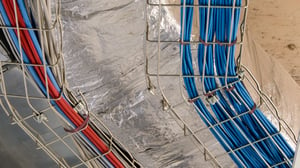(This blog post from VELCRO® Brand provides insight into how their solutions can help you keep in line with industry standards when completing cable installations. Check it out! -Teddi)
When working on cable installations, hook and loop cable ties give the installer a much better chance of avoiding an industry standard violation for several reasons. Don’t risk having to re-do a job because it violated cable installation standards. Get the peace of mind you need with VELCRO® Brand ONE-WRAP® cable ties.

General Cable Installation Standards
ANSI/TIA, BICSI and AVIXA have established specific guidelines on how to properly install low voltage cable pathways and spaces that maximize data flow and ensure cables are secure while reducing the risk of damage. Many customers and jurisdictions may require strict compliance with these guidelines, but it’s a good idea to adhere to them, regardless.
ANSI/TIA-568.0-D says: “Cable stress, such as that caused by tension in suspended cable runs and tightly cinched bundles, should be minimized. Cable bindings, if used to tie multiple cables together, should be irregularly spaced and loosely fitted (easily moveable).”
The BICSI ITSIMM manual says: “Hook and loop straps should be used to prevent a change in the physical geometry of the cable that typically results from use of nylon cable ties.”
AVIXA F502.01:2018 says: “Hook and loop shall be used on all category cables, coaxial, and fiber cables. Spacing between cable ties shall be three (3) times diameter of the loom or 10 cm (~4 inches), whichever is smaller and unevenly spaced.”
How ONE-WRAP® Cable Ties Apply
ONE-WRAP® cable ties are soft & flexible to adapt to curved pathways and avoid over cinching. Additionally, when it comes to adds, moves and changes, removing traditional plastic ties runs the risk of cinching too tight, restricting data flow and potentially damaging cable jackets.
Additionally, when it comes to moves, adds and changes, hook and loop cable ties are less arduous, as opposed to cutting plastic ties, creating clutter and risking damage to cables. You don’t want to have to rip out all of your plastic ties because the building inspector found over cinched cables. Hook and loop is the safer option.

Fire Codes & Hazards
Working in plenum space is inevitable for cable installations and it’s often a delicate process when it comes to building codes. If your installation needs to be plenum-rated, you’ll need cables and fasteners that comply.
National Electrical Code says: “Cables shall be supported by straps, staples, hangers, cable ties or similar fittings designed and installed so as not to damage the cable. Nonmetallic cable ties and other nonmetallic cable accessories used to secure and support cables shall be listed as having low smoke and heat release properties.”
How ONE-WRAP® Cable Ties Apply
VELCRO® Brand ONE-WRAP® Fire Retardant cable ties are UL-rated, designed to be used in plenum space and flexible to eliminate damage to cables. If you’re frequently working in plenum space, it may be wise to get into the habit of using only ONE-WRAP® FR cable ties on all installations, to eliminate any confusion among which ties are which.
It’s important always to be aware of your local cable installation standards and building codes. Considering all other components involved in an installation, VELCRO® Brand ONE-WRAP® cable ties won’t completely ensure you’re up to code, but they will significantly help you with inspections. Contact your local Accu-Tech representative to learn more.


.png?width=58&height=58&name=X_logo_2023_(white).png)
